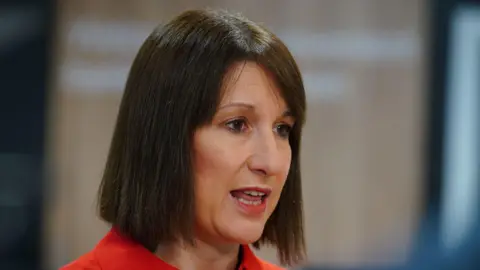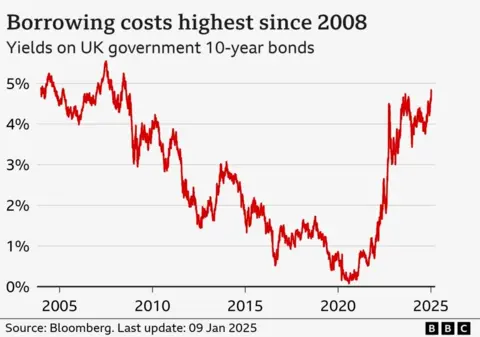 PA Media
PA MediaChancellor Rachel Reeves is travelling to China in a bid to boost trade and economic ties, as she faces increasing pressure after government borrowing costs hit their highest level in years.
The three day-visit has been criticised by some Conservatives, who say she should have cancelled the trip to prioritise economic issues at home.
Higher government borrowing costs means spending more tax revenue, leaving less money to spend on other things.
Economists have warned this could mean spending cuts, affecting public services, or tax rises that could hit people’s pay or businesses’ ability to grow.
Travelling to China with the chancellor are senior financial figures, including the governor of the Bank of England and the chair of HSBC.
There she will meet China’s Vice Premier He Lifeng in Beijing before flying to Shanghai for discussion with UK firms operating in China.
The government is looking to revive an annual economic dialogue with China that has not been held since the pandemic.
Ties have been strained in recent years by growing concerns about the actions of China’s Communist leaders, allegations of Chinese hacking and spying and its jailing of pro-democracy figures in Hong Kong.
The Conservatives have criticised the chancellor for proceeding with the planned trip rather than staying in the UK to address the cost of government borrowing and slide in the value of the pound.
Shadow chancellor Mel Stride accused Reeves of being “missing in action” and said she should have stayed in the UK.
But Chief Secretary to the Treasury Darren Jones, standing in for Reeves in the Commons on Thursday, said the trip was “important” for UK trade and there was “no need for an emergency intervention”.
Former chancellor Philip Hammond also told the World at One programme on Thursday that he “wouldn’t personally recommend the chancellor cancels her trip to China. This can wait until she gets back next week”.

Governments generally spend more than they raise in tax so they borrow money to fill the gap, usually by selling bonds to investors.
Interest rates – known as the yield – on government bonds have been going up since around August, a rise that has also affected government bonds in the US and other countries.
The yield on a 10-year bond has surged to its highest level since 2008, while the yield on a 30-year bond is at its highest since 1998, meaning it costs the government more to borrow over the long term.
Reeves has previously committed only to make significant tax and spend announcements once a year at the autumn Budget.
But if higher borrowing costs persist, there is the possibility of cuts to spending before that or at least lower spending increases than would otherwise happen.
Any further spending cuts could be announced in the chancellor’s planned fiscal statement on 26 March , ahead of a spending review that has already asked government departments to find efficiency savings worth 5% of their budgets.



